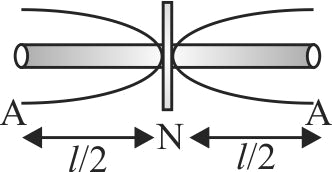354886
A steel rod \(2.5\;m\) long is rigidly clamped at its centre \(C\) and longitudinal waves are set up on both sides of \(C\) by rubbing along the rod.
\({Y_{steel{\text{ }}}} = 2 \times {10^{11}}\;N/{M^2}\)
\({\rho _{steel{\text{ }}}} = 8000\;kg/{m^3}\)
If two antinodes are observed on either side of \(C\), the frequency of the mode in which the rod is vibrating will be:
354886
A steel rod \(2.5\;m\) long is rigidly clamped at its centre \(C\) and longitudinal waves are set up on both sides of \(C\) by rubbing along the rod.
\({Y_{steel{\text{ }}}} = 2 \times {10^{11}}\;N/{M^2}\)
\({\rho _{steel{\text{ }}}} = 8000\;kg/{m^3}\)
If two antinodes are observed on either side of \(C\), the frequency of the mode in which the rod is vibrating will be:
354886
A steel rod \(2.5\;m\) long is rigidly clamped at its centre \(C\) and longitudinal waves are set up on both sides of \(C\) by rubbing along the rod.
\({Y_{steel{\text{ }}}} = 2 \times {10^{11}}\;N/{M^2}\)
\({\rho _{steel{\text{ }}}} = 8000\;kg/{m^3}\)
If two antinodes are observed on either side of \(C\), the frequency of the mode in which the rod is vibrating will be:
354886
A steel rod \(2.5\;m\) long is rigidly clamped at its centre \(C\) and longitudinal waves are set up on both sides of \(C\) by rubbing along the rod.
\({Y_{steel{\text{ }}}} = 2 \times {10^{11}}\;N/{M^2}\)
\({\rho _{steel{\text{ }}}} = 8000\;kg/{m^3}\)
If two antinodes are observed on either side of \(C\), the frequency of the mode in which the rod is vibrating will be:




